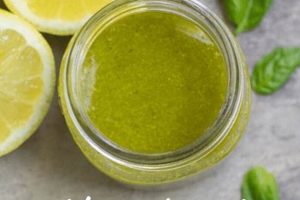A blend of olive oil, lemon juice, and herbs like oregano and basil forms the foundation of a classic Mediterranean-style vinaigrette. Variations often include garlic, Dijon mustard, red wine vinegar, or capers for added depth and complexity. This versatile dressing enhances the flavors of fresh vegetables, feta cheese, olives, and other ingredients commonly found in Mediterranean cuisine. For example, a simple preparation might involve whisking together three parts olive oil, one part lemon juice, minced garlic, dried oregano, salt, and pepper.
Emulsified oil and vinegar dressings, like this style, offer a healthy and flavorful way to enjoy fresh produce. The high monounsaturated fat content of olive oil contributes to cardiovascular health, while lemon juice provides vitamin C and antioxidants. Historically, similar dressings have been a staple in Mediterranean regions for centuries, reflecting the readily available local ingredients and a culinary emphasis on fresh, seasonal flavors. Their continued popularity stems from both their health benefits and the bright, vibrant taste they impart.
This exploration will delve further into the various ingredients, techniques, and variations involved in crafting delicious Mediterranean-style dressings, offering insights into achieving the perfect balance of flavors and textures. It will also cover suitable pairings and creative applications for both traditional and contemporary interpretations of this culinary staple.
Tips for Crafting Exceptional Mediterranean Dressings
Achieving a balanced and flavorful Mediterranean dressing requires attention to detail and an understanding of the interplay between core ingredients. These tips offer guidance for consistent, high-quality results.
Tip 1: Use High-Quality Olive Oil: The foundation of any Mediterranean dressing lies in its olive oil. Opt for extra virgin olive oil, preferably cold-pressed, for the best flavor and aroma. The quality of the oil significantly impacts the final taste.
Tip 2: Freshly Squeezed Lemon Juice is Key: Bottled lemon juice often contains preservatives and lacks the vibrant, fresh taste of freshly squeezed lemons. This seemingly small detail elevates the entire dressing.
Tip 3: Balance Acidity: While lemon juice provides essential acidity, excessive tartness can be overpowering. Taste and adjust the balance by adding more olive oil or a touch of sweetness, such as a pinch of sugar or a drizzle of honey.
Tip 4: Explore Herb Variations: Fresh herbs like oregano, basil, mint, and thyme contribute distinct aromatic notes. Experiment with different combinations to discover preferred flavor profiles. Dried herbs offer a convenient alternative but should be used sparingly due to their concentrated flavor.
Tip 5: Emulsify Thoroughly: Proper emulsification creates a creamy, cohesive texture and prevents the dressing from separating. Whisk the ingredients vigorously or use a blender for a smooth, consistent result.
Tip 6: Seasoning Matters: Salt and freshly ground black pepper are essential for enhancing the overall flavor profile. Sea salt or kosher salt are recommended. Taste and adjust seasoning as needed.
Tip 7: Consider Additional Ingredients: Ingredients such as minced garlic, Dijon mustard, red wine vinegar, capers, or crumbled feta cheese add complexity and depth. Start with small amounts and adjust to preference.
By following these guidelines, one can consistently create flavorful and well-balanced Mediterranean dressings that complement a wide array of dishes. The emphasis on fresh, high-quality ingredients allows the natural flavors to shine through.
These techniques lay the groundwork for exploring more complex variations and personalized adaptations, allowing for a deeper appreciation of this versatile culinary staple.
1. Fresh Ingredients
The emphasis on fresh ingredients distinguishes a truly exceptional Mediterranean salad dressing. Quality and seasonality significantly impact the final flavor profile, elevating the dressing from ordinary to extraordinary. Freshness enhances the vibrancy and complexity, allowing the inherent flavors of each component to shine.
- High-Quality Olive Oil
Extra virgin olive oil, preferably cold-pressed, forms the base of the dressing. Its fruity, peppery notes contribute significantly to the overall flavor. Selecting high-quality olive oil is crucial, as inferior oils can introduce undesirable flavors. A taste test comparing different olive oils highlights the noticeable impact of quality on the final dressing.
- Freshly Squeezed Citrus
Freshly squeezed lemon juice provides essential acidity and brightness. Unlike bottled varieties, fresh juice offers a vibrant, clean flavor without the preservatives and additives that can detract from the delicate balance. The difference between freshly squeezed and bottled lemon juice is readily apparent in a side-by-side comparison.
- Aromatic Herbs
Fresh herbs like oregano, basil, mint, and thyme contribute distinct aromatic complexities. Their flavors are more pronounced and nuanced than dried counterparts. Incorporating freshly chopped herbs elevates the sensory experience of the dressing. A simple experiment using both fresh and dried herbs in identical dressings demonstrates the superior flavor provided by fresh herbs.
- Seasonal Produce in the Salad Itself
While not directly part of the dressing, the freshness of the salad ingredients plays a crucial role in the overall culinary experience. Seasonal vegetables, ripe tomatoes, and crisp cucumbers enhance the impact of the dressing. A winter salad with out-of-season tomatoes, for example, will not fully benefit from even the finest dressing.
Prioritizing fresh, high-quality ingredients in both the dressing and the salad itself maximizes flavor and nutritional value. This emphasis on freshness underscores the core principles of Mediterranean cuisine, where simplicity and seasonality are celebrated. The synergistic relationship between fresh components creates a harmonious and vibrant culinary experience.
2. Olive Oil Base
Olive oil constitutes the foundational element of a Mediterranean salad dressing, profoundly influencing its flavor, texture, and nutritional value. This central role stems from the oil’s inherent properties and its significance within Mediterranean cuisine. The cause-and-effect relationship between olive oil quality and the overall dressing quality is direct and demonstrable. High-quality extra virgin olive oil, characterized by its low acidity and robust flavor profile, contributes fruity, peppery notes and a smooth, luxurious mouthfeel. Conversely, using lower-quality olive oil can result in a bland or even unpleasant taste, diminishing the dressing’s impact. A simple comparison between dressings made with different grades of olive oil reveals a stark contrast in flavor and aroma.
The importance of olive oil as a component extends beyond flavor. Its high content of monounsaturated fats offers significant health benefits, aligning with the broader nutritional principles of the Mediterranean diet. Olive oil contributes to cardiovascular health, reduces inflammation, and provides essential fatty acids. Furthermore, it acts as a carrier for the flavors of other ingredients, such as herbs and spices, allowing them to fully express themselves within the dressing. For instance, a lemon-herb vinaigrette relies on the olive oil to distribute the flavors of lemon juice, oregano, and garlic evenly throughout the emulsion. The practical significance of understanding this relationship lies in the ability to select appropriate olive oils for specific flavor profiles. Delicate oils complement lighter salads, while more robust oils pair well with heartier ingredients like grilled vegetables or roasted meats.
In summary, the olive oil base forms the backbone of a Mediterranean salad dressing, influencing both its sensory characteristics and nutritional value. Selecting high-quality olive oil and understanding its interplay with other ingredients are crucial for crafting exceptional dressings. This knowledge allows for informed decision-making and empowers culinary exploration within the context of this vibrant and healthful cuisine. The impact of olive oil selection extends beyond the immediate dish, reflecting a broader appreciation for the role of quality ingredients in achieving culinary excellence.
3. Citrus Acidity
Citrus acidity plays a crucial role in Mediterranean salad dressings, providing a bright, refreshing counterpoint to the richness of olive oil. This balance of flavors is essential for achieving the characteristic vibrancy of Mediterranean cuisine. The primary source of this acidity is typically lemon juice, although other citrus fruits like lime or orange can also be used. The effect of citrus acidity is multifaceted. It brightens the overall flavor profile, cuts through the richness of the olive oil, and helps to emulsify the dressing, creating a stable and cohesive mixture. Furthermore, the acidity interacts with other ingredients, enhancing the flavors of herbs and spices. For example, the sharpness of lemon juice accentuates the herbaceous notes of oregano and thyme. A dressing lacking sufficient acidity would taste flat and overly oily.
The importance of citrus acidity as a component of Mediterranean salad dressings is underscored by its historical and cultural significance. Citrus fruits have been cultivated in the Mediterranean region for centuries, and their use in culinary preparations is deeply ingrained in the region’s traditions. Beyond its flavor contribution, citrus juice also offers nutritional benefits, providing Vitamin C and antioxidants. Different types of citrus fruits offer varying levels of acidity and unique flavor profiles. Lemon juice provides a sharp, tangy flavor, while lime juice offers a slightly more floral aroma. Orange juice, although less commonly used, can contribute a sweeter, more mellow acidity. Choosing the appropriate citrus fruit depends on the desired flavor profile and the other ingredients in the salad. For instance, a salad featuring delicate greens and herbs might benefit from the subtle acidity of lime juice, while a more robust salad with grilled vegetables might pair well with the stronger acidity of lemon juice.
Understanding the role of citrus acidity allows for precise control over the final flavor profile of a Mediterranean salad dressing. Balancing acidity with the richness of olive oil and the aromatics of herbs and spices is key to achieving a harmonious and flavorful result. This balance reflects a broader principle of Mediterranean cuisine, which emphasizes the interplay of fresh, high-quality ingredients. Mastering this balance allows for creative exploration within the framework of traditional flavors, ultimately enhancing the culinary experience.
4. Aromatic Herbs
Aromatic herbs constitute an essential element of Mediterranean salad dressings, contributing layers of flavor and complexity that complement the other core ingredients. Their distinctive aromas and flavors enhance the sensory experience, transforming a simple vinaigrette into a culinary delight. Understanding the role and interplay of these herbs is crucial for crafting well-balanced and flavorful dressings.
- Classic Mediterranean Herbs
Oregano, basil, mint, and thyme represent quintessential Mediterranean herbs frequently used in salad dressings. Oregano offers a pungent, slightly bitter flavor, while basil contributes a sweeter, more peppery note. Mint provides a refreshing coolness, and thyme adds an earthy, slightly lemony aroma. These herbs can be used individually or in combination, depending on the desired flavor profile. For example, a classic Greek salad dressing typically features oregano and mint, while a dressing for a tomato and cucumber salad might include basil and thyme.
- Fresh vs. Dried Herbs
Fresh herbs offer a brighter, more nuanced flavor compared to their dried counterparts. However, dried herbs provide a convenient alternative and have a longer shelf life. When using dried herbs, it is important to use them sparingly, as their flavor is more concentrated. A general guideline is to use one-third the amount of dried herbs compared to fresh. The difference in flavor intensity can be easily demonstrated by comparing dressings made with fresh and dried oregano.
- Balancing Herbal Flavors
The key to using aromatic herbs effectively lies in achieving balance. Overpowering the dressing with too much of any single herb can mask the other flavors. Starting with small amounts and tasting as you go allows for precise control over the final flavor profile. The interplay between herbs and other ingredients, such as citrus and garlic, is also crucial. For example, the sharpness of lemon juice can enhance the herbaceous notes of oregano, while the pungent flavor of garlic can complement the sweetness of basil.
- Regional Variations
Different regions within the Mediterranean utilize varying combinations of herbs in their traditional cuisine. For example, parsley and dill are commonly used in Middle Eastern dressings, while marjoram and rosemary are more prevalent in some parts of North Africa. Exploring these regional variations can inspire creative adaptations and expand one’s culinary repertoire. Comparing a Greek salad dressing with a Moroccan chermoula, for instance, highlights the diverse applications of herbs in Mediterranean cuisine.
The careful selection and application of aromatic herbs elevate Mediterranean salad dressings beyond simple condiments, transforming them into integral components of a flavorful and healthful culinary experience. Understanding the nuances of these herbs, their individual characteristics, and their interplay with other ingredients unlocks the potential for creating truly exceptional dressings that capture the essence of Mediterranean cuisine. This knowledge empowers culinary experimentation and personalization, leading to a deeper appreciation for the role of herbs in enhancing both flavor and overall culinary artistry.
5. Balanced Flavor
Balanced flavor represents a cornerstone of successful Mediterranean salad dressings, distinguishing a truly exceptional vinaigrette from a mediocre one. This balance stems from the harmonious interplay of key components: the richness of olive oil, the brightness of citrus acidity, the pungency of herbs, and the subtle influence of additional ingredients like garlic or mustard. A well-balanced dressing exhibits no single dominant flavor; rather, each element complements and enhances the others, creating a unified and harmonious whole. An overly acidic dressing, for instance, overwhelms the other flavors, while a dressing lacking sufficient acidity tastes flat and oily. The cause-and-effect relationship between balance and enjoyment is undeniable; a harmonious dressing elevates the entire culinary experience.
The importance of balanced flavor as a component of a Mediterranean salad dressing cannot be overstated. It is not merely a desirable characteristic but a fundamental principle that governs the creation of successful recipes. This principle reflects the broader philosophy of Mediterranean cuisine, which emphasizes the synergistic relationship between fresh, high-quality ingredients. A classic Greek salad, for example, exemplifies this balance: the salty feta cheese, the briny olives, the crisp cucumbers, and the juicy tomatoes are all brought together by a simple lemon-oregano vinaigrette. The dressing does not compete with the other ingredients but rather enhances their individual flavors, creating a cohesive and satisfying culinary experience. Practical application of this understanding involves careful consideration of each ingredient’s contribution and the adjustments needed to achieve optimal flavor harmony. This might involve increasing the amount of olive oil to temper excessive acidity or adding a pinch of sugar to balance the bitterness of certain herbs.
Achieving balanced flavor in a Mediterranean salad dressing requires both a nuanced understanding of flavor profiles and a willingness to experiment. While recipes provide a starting point, true mastery lies in the ability to adapt and adjust based on the specific ingredients at hand and the desired outcome. Successfully navigating this complexity unlocks the potential for creating dressings that not only complement a salad but also enhance its individual components, elevating the entire dish from simple to sublime. This focus on balance reflects a broader culinary principle applicable far beyond Mediterranean cuisine, emphasizing the transformative power of thoughtful ingredient combination and the pursuit of harmonious flavor profiles.
6. Versatile Application
The versatility of Mediterranean salad dressings extends beyond their traditional role as a simple salad accompaniment. Their adaptable nature stems from the balanced flavor profile, derived from the harmonious blend of olive oil, citrus acidity, and aromatic herbs. This balance allows them to complement a wide range of dishes, transcending cultural boundaries and culinary contexts. Understanding this versatility unlocks a wealth of culinary possibilities, expanding the role of these dressings beyond the confines of the salad bowl.
- Marinades for Meats and Poultry
Mediterranean dressings function exceptionally well as marinades, particularly for grilled or roasted meats and poultry. The acidity in the dressing helps to tenderize the meat, while the olive oil and herbs infuse it with flavor. For example, chicken marinated in a lemon-herb dressing gains a bright, herbaceous flavor profile that complements the smoky char of the grill. The emulsification of the dressing also helps to keep the meat moist during cooking.
- Vegetable Enhancement
Beyond leafy greens, Mediterranean dressings enhance a variety of vegetables, both raw and cooked. Roasted vegetables, such as zucchini, bell peppers, and eggplant, benefit from a drizzle of this vinaigrette, adding a bright, acidic counterpoint to their natural sweetness. Similarly, raw vegetables like carrots, celery, and cherry tomatoes gain complexity and depth when tossed with a flavorful Mediterranean dressing.
- Grain Bowl Component
The versatility of Mediterranean dressings extends to grain bowls, where they serve as a unifying element, binding together diverse ingredients. Quinoa, farro, or rice bowls gain a vibrant flavor dimension when tossed with a lemon-herb vinaigrette. The dressing complements the grains while also enhancing the flavors of other components, such as roasted vegetables, chickpeas, or feta cheese.
- Seafood Complement
Grilled or pan-seared fish, particularly white fish like cod or sea bass, benefit from the bright, clean flavors of a Mediterranean dressing. The acidity cuts through the richness of the fish, while the herbs provide a refreshing counterpoint. A simple drizzle of lemon-oregano vinaigrette elevates a grilled fish dish, adding depth and complexity without overpowering the delicate flavor of the seafood.
These diverse applications demonstrate the adaptability of Mediterranean salad dressings. Their balanced flavor profiles and inherent versatility allow them to enhance a wide array of dishes, extending far beyond their traditional role in salads. This adaptability reflects the resourcefulness and culinary ingenuity found within Mediterranean cuisine, where simple, high-quality ingredients are transformed into flavorful and versatile culinary foundations. Understanding this versatility unlocks a world of culinary possibilities, encouraging experimentation and creative exploration in the kitchen.
Frequently Asked Questions
This section addresses common inquiries regarding Mediterranean salad dressings, providing concise and informative responses to facilitate a deeper understanding of their preparation and utilization.
Question 1: What distinguishes a Mediterranean salad dressing from other vinaigrettes?
Mediterranean salad dressings are characterized by the use of olive oil, lemon juice or red wine vinegar, and a blend of herbs traditionally found in the Mediterranean region, such as oregano, basil, mint, and thyme. These dressings prioritize fresh, high-quality ingredients and emphasize a balance of flavors.
Question 2: Can bottled lemon juice be substituted for fresh?
While bottled lemon juice offers convenience, fresh lemon juice is strongly recommended for optimal flavor. Bottled juice often contains preservatives and lacks the vibrant taste of freshly squeezed lemons, which can significantly impact the overall quality of the dressing.
Question 3: How can the emulsion be prevented from separating?
Vigorous whisking or the use of a blender helps to create a stable emulsion. Adding a small amount of Dijon mustard can also act as an emulsifier, binding the oil and vinegar together more effectively.
Question 4: What are some suitable herb combinations for Mediterranean dressings?
Classic combinations include oregano and mint, basil and thyme, or a blend of all four. Experimentation with other Mediterranean herbs like marjoram, rosemary, or dill can also yield interesting flavor profiles.
Question 5: How long can a homemade Mediterranean dressing be stored?
Stored in an airtight container in the refrigerator, homemade Mediterranean dressings typically last for up to one week. Fresh herbs may wilt over time, but the flavor of the dressing remains intact.
Question 6: Beyond salads, how else can Mediterranean dressings be utilized?
Their versatility extends to marinades for meats, poultry, and fish, as well as a flavorful addition to roasted vegetables, grain bowls, and dips. The inherent balance of flavors makes them a versatile culinary tool.
Understanding these key aspects of Mediterranean salad dressings empowers informed choices and facilitates culinary exploration, encouraging both adherence to traditional methods and creative adaptation.
The following section will explore specific recipe variations and offer practical tips for crafting exceptional Mediterranean salad dressings at home.
Recipe Mediterranean Salad Dressing
Exploration of Mediterranean salad dressing recipes reveals a culinary tradition grounded in fresh, high-quality ingredients and a balanced flavor profile. Emphasis on extra virgin olive oil, fresh citrus juice, and aromatic herbs like oregano and basil forms the foundation of these versatile dressings. Understanding the interplay of these core components allows for both adherence to classic preparations and informed experimentation. The significance of proper emulsification and the potential for incorporating additional ingredients like garlic or Dijon mustard further expands the possibilities within this culinary framework. Adaptability extends beyond salads, encompassing marinades, vegetable enhancements, and integrations into grain bowls and seafood preparations.
Mastery of Mediterranean salad dressing recipes offers a pathway to not only flavorful enhancements but also a deeper understanding of culinary principles applicable across a range of cuisines. This exploration encourages informed ingredient selection, precise flavor balancing, and creative adaptation to personal preferences and culinary contexts. The enduring popularity of these dressings speaks to the timeless appeal of fresh, vibrant flavors and the potential for culinary artistry within the realm of seemingly simple preparations. Continued exploration within this culinary domain promises further discovery and enjoyment.






